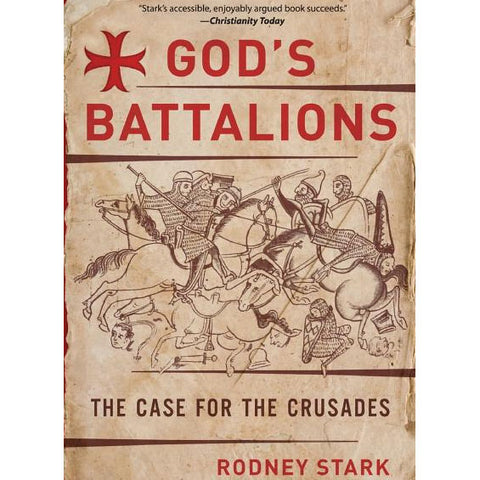Catholic Book Review: God's Battalions

Christians Should Celebrate the Crusades, Not Shame Them
Out of all of the events in Christianity’s long and eventful history, none have created more animosity and bitterness towards the Faith than the Crusades. All too often we are told the grim tale of the barbaric and greedy crusaders who traveled to the Holy Land to capture land and loot in the name of claiming converts for Christianity, all while terrorizing the peaceful Muslim inhabitants and committing intellectual theft against their more civilized and advanced culture. The problem with this common version of the story is that it is almost entirely false, as sociologist Rodney Stark proves in his book titled “God’s Battalions: The Case For The Crusades.”
Dr. Stark is co-director for the Institute for Studies of Religion at Baylor and the best-selling author of “The Rise of Christianity.” In this book, Dr. Stark dismantles the dominant narrative repeated about the Crusades and analytically invalidates the previously held assumptions by scholars, historians, and religious leaders about this controversial event. This book not only proves the common claim made about the reasons for the Crusades false, but also challenges many facts of the campaigns that have been crafted with the purpose of putting the crusaders in a negative light, along with all of Christianity.
Rodney Stark’s book consists of ten chapters. The book’s timeline goes through the early Muslim incursions into the Christian West, the start of the Crusades, the capture of Jerusalem and the establishment of the Crusader States, and the eventual fall of these kingdoms to resurgent Muslim forces. This book was as informative as it was entertaining. I could hardly put it down! Although there is a lot of information and facts for the reader to digest, it isn’t so much so as to overwhelm the reader. Details about battle formations, geography, and stories of prominent individuals all serve the greater purpose of proving Stark’s thesis and make his book a much more engaging and thrilling read.
Stark also relies heavily on studies and prominent scholars who have detailed histories of the Crusades. He incorporates tables and statistics quite prominently to prove his points, such as his data table used to illustrate the years it required to convert primarily Christian and Jewish areas into Islamic ones (Stark, 31-32). This aspect of his book ensures the reader is gaining reliable information and an expert opinion.
The most important feature of “God’s Battalions” is its refutation of the most persistent misunderstandings about the Crusades: why they happened. The most common claim is that the Crusades were launched to conquer new lands, take possession of valuables and loot, and to convert as many people to Christianity as possible. However, Stark demonstrates that this is simply not true. The Crusades were launched in 1096, yet Muslim incursions and conquests of Christian lands had been occurring for hundreds of years prior. These conquests all involved the murder, rape, and enslavement of Christians and the desecration of holy sites such as the Holy Sepulchre by the Fatmid Caliphate in 996 (910). This issue was so urgent that when Pope Urban ll gave his infamous speech at Clermont, he detailed the persecution of Christian pilgrims as one of the primary reasons for the Crusades needing to be launched.
Other myths surrounding the Crusades are also thoroughly and factually disproved. For example, crusaders didn’t make the grueling journey to the Holy Land and risk death by sword and sickness to gain land or wealth. Rather, they went because they felt they had been called by God to defend the cradle of their religion; the Crusades were also a way to atone for the many sins that knights often committed during war. Additionally, the crusaders often sold most of their possessions in order to finance their journey and expected very little in return.
Nor was Islamic culture in a thriving “Golden Age,” as so often mentioned in books and entertainment, when the Christian forces arrived in the Levant. While it is true that many advances were made in the Islamic world, they were usually the result of the non-Muslim subjects living under Islamic rule, such as Christians, Jews, and Zoroastrians among others. One particular example is how the only way Muslims were able to ever construct fleets to defeat later crusader armies was by copying the designs of European ships (75).
Stark illustrates that Islamic society was not only not “advanced,”but it also wasn’t incredibly “civilized” either. While the massacres of civilian populations committed by crusaders are routinely highlighted to bring modern followers of Christ to shame, the same acts committed by Muslims are often overlooked, as Stark lists countless atrocities committed against civilians by Muslim soldiers. Take the famous Muslim leader Saladin for example. He is routinely cited as being a tolerant and merciful ruler when compared to the cruelty of the Christian soldiers. Yet in reality, he was quite brutal, often beheading prisoners of war and selling city inhabitants into slavery, as illustrated by what he did to half of the population of Jerusalem in 1187 (198). Stark stresses how the rules of war during this time were very different from what they are now, and that by “imposing the Geneva Convention on this time,” we as a modern society gain nothing (158).
Rodney Stark’s “God’s Battalions” creates an urgent need for Christians, and people as a whole, to take a closer look at the Crusades. This event is not as black and white as it has been historically portrayed, but rather it is a complex tale that details the desperate struggle of Christian Europe against the approaching Islamic hordes. The men who fought as crusaders were not greedy plunderers, but rather devout Christians who were fighting for their lives, their civilization, and their faith. These soldiers should not be depicted as villains but venerated as heroes instead. After reading this book, I am more than convinced that they were truly serving in God’s battalions.
